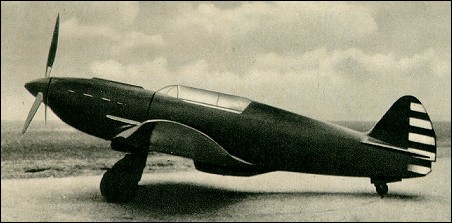|
| Design of the Yakovlev Yak-1 medium-altitude interceptor/fighter began in November 1938, and from it evolved a series of remarkable aircraft (produced in vast numbers) which made an important mark in the history of aviation. Known initially as the I-26, the type had a wooden wing combined with a fuselage of mixed construction and main landing gear units retracting inwards into the underside of the wing. The I-26 looked a thoroughbred and was dubbed 'Beauty' by its design team. Flown initially on 13 January 1940, the first prototype was soon lost in a fatal accident, but the development programme was continued without any break by the second prototype which incorporated some improvements. A pre-production batch of Yak-1s was flying by the end of the year and 64 initial series machines had also been completed by then. Changes were introduced during the course of production and many aircraft of the main variants were completed from early 1942 with all increased span more pointed wing. A new pilot's canopy and cut-down rear fuselage were introduced on the Yak-1B and reduction of overall weight was achieved with the Yak-1M. The mount of many leading Soviet fighter pilots, Yak-1s equipped a high proportion of fighter squadrons from 1942 onwards, when the type was phased out of production in mid-1943, a total of 8,721 series aircraft of all versions had been completed.

| CREW | 1 |
| ENGINE | 1 x VK-105PF, 870kW |
| WEIGHTS |
| Take-off weight | 3000 kg | 6614 lb |
| Empty weight | 2330 kg | 5137 lb |
| DIMENSIONS |
| Wingspan | 10.0 m | 33 ft 10 in |
| Length | 8.5 m | 28 ft 11 in |
| Height | 1.7 m | 6 ft 7 in |
| Wing area | 17.2 m2 | 185.14 sq ft |
| PERFORMANCE |
| Max. speed | 580 km/h | 360 mph |
| Ceiling | 10000 m | 32800 ft |
| Range | 850 km | 528 miles |
| ARMAMENT | 1 x 20mm machine-guns, 2 x 7.62mm machine-guns, 6 missiles |
 | A three-view drawing (1655 x 1270) |
| Ian, e-mail, 07.02.2016 15:55 Soviet pilots preferred lighter aicraft with greater manouevreability. To this end they would even REMOVE wing guns and anything which they believed would add unnecessary weight. They relied on accuracy more than fire-power. reply | | D. Rossi, e-mail, 25.09.2010 20:40 The first time I saw Anna Kreisling she was sitting in the cockpit of a captured Yak fighter. I was only 12 at the time and thought I had seen a goddess. My father was working on a top secret longevity project and Anna was somehow involved. He desparately wanted me to see her and said this was probably the only opportunity I would have in my entire life as she would soon "disappear". Although at the time I didn't have the experience to fully appreciate what my father had done for me I still vividly remember how well built the Yak and Anna were. reply |
| Ron, e-mail, 02.08.2010 08:41 If your struck by the lack of guns on Soviet fighters in WW2,
they are few but most effective when you look closely.
The hub cannon on this Yak-1 had a rate of up to 800 rounds per minute. So in round numbers, that's 13 per second at 96 grams each. Thus you have 1.28 kg per second (not counting high explosive effect of the HE shells). That leaves 72 grams per second for the UBS 12.7-mm synchronized cowl machine gun. The means it fired 15 rps which is 900 rpm if each shell is 48 grams average (some with HE). I know the published rate was 800 rpm but do the math yourself. No other 12.7 guns could do even 800 rpm let alone 900 - synchronized. And with such heavy ammo besides. Muzzle velocity was still good too. The M3 Browning could fire 1200 rpm on the P-47N but that wasn't until 1945 and it wasn't synchronized through the prop like this 1940-1 Yak-1. In 1941 the P-39 cowl mounted Brownings were synchronized at a rate of 300 rpm each for comparison (as a closer contemporary fighter). So 1 UBS was equal to 3 Browning 12.7-mm (0.50 Cal. with lighter ammo on average besides). True the early Yak-1 had the light ShKAS machine guns firing a rate of 1625+ rpm each synchronized. These Yaks thus had longer useful firing range since they were not using wing guns that converged only at a certain range. reply | | Ronald, e-mail, 02.09.2008 07:55 Weight of fire / sec. salvo = 1.856kg-2.000kg
Climb to 5km = 4.5-6.8 min
360 turn = 17-21 sec. reply |
|
Do you have any comments?
|
| 
COMPANY
PROFILE
All the World's Rotorcraft
|









Who is anna Kreisling?
reply